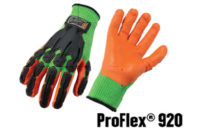Too often, though, these efforts focus primarily on the palm side of the hand. Less attention is paid to protecting the back (or dorsal) side, which is critical for our hands to operate effectively. This becomes even more important in extreme environments where dorsal side injuries are more common. Think oil and gas drilling, extraction and refining; mining; heavy construction; demolition; cargo handling; and other industrial settings.
Bone up on hand anatomy
When we are very familiar with something, we say we “know it like the back of our hand.” However, hands are complex. There is a lot to know. Start with the bones. Each hand is comprised of 27: 14 in the fingers, eight in each wrist, and five in the metacarpus or palm. Movement of these bones is controlled by forearm muscles which are connected to the bones via tendons. In some ways, it’s helpful to think of our hands as marionettes. Muscles pull strings (tendons) on the bottom side of our forearms which cause our fingers to grip (a movement known as flexion). Muscles on the back side of our forearm cause fingers to open (a movement called extension). Both are critical for work; you do need to let go of things after all. The smaller hand muscles allow for delicate movements and work with nerves and blood vessels to allow feeling and for using our hands effectively.
Injuries to these bones, tendons or muscles are often caused by an impact, a pinch or a blow. And these injuries can be significant. Damage to just one hand component can make a worker less effective or even prevent them from performing their duties completely. Natural protection for the palmar side of the hand is provided by thicker skin and numerous cell layers. These layers can be enhanced with calluses, essentially thickened by pads of dead skin cells built up for work. Still more padding is provided by muscles and fat cells.
One-sided solutions
The vast majority of hand protection solutions (i.e. gloves) focus on the palm side of the hand. Gloves designed to protect against cuts, abrasions, burns, impact or vibration do so with special padding, thick leather or other heavy materials.
Most often, these gloves address the dorsal side with a thinner material offering minimal protection. This “other side of the hand” with its thinner skin and fewer muscles is less naturally protected from injuries. And that makes wearing gloves that focus only on the palm side of the hand like wearing sandals – fine for a walk on the beach, but not appropriate for work environments where both sides are at risk.
Injury prevention
Engineering controls are always the preferred method of hand injury prevention. Designing work environments, equipment and tasks so that workers’ hands are never placed in jeopardy is the best approach. However, this is not always realistic, especially when workers are engaged in construction, assembly, disassembly or repair-type tasks that require hand tools or extreme handling. Training, work practices and administrative controls are also effective in keeping workers’ hands out of danger zones. They can prevent impact, pinch or blow injuries when working around moving parts, equipment or large loads. Examples include tag lines, tools and reach poles. However, the success of this type of ‘hands-off’ policy requires that it be effectively promoted and enforced.
Too much bulk makes workers balk
Some tool manufacturers have designed their hand and power tools to protect the dorsal side of the hand in a way similar to sword hilts. This can be seen in the brush guard on most modern chainsaws. Unfortunately, these types of guards are sometimes ‘clunky’ and limited in their effectiveness. Similarly, hockey and boxing have produced unique gloves offering substantial dorsal protection – but obviously unsuitable for work applications. The padded bulk of the boxing glove only works with a fist while the dorsal padding on a goalie glove prevents the wearer from grasping anything more delicate than a hockey stick.
Thickly padded gloves also raise concerns in work applications. Where hand clearances are already limited, bulky gloves can interfere with access to parts or fasteners, making fine work difficult. Bulky gloves also increase the chance of getting caught in moving parts when working around moving equipment or machinery. Of course, in warm climates and hot environments thickly padded gloves can be uncomfortable. All of the above may lead to workers choosing not to wear the glove, leaving their hands exposed and more vulnerable to injury.
Protection, dexterity & fit
So how do you protect both sides of the hands while still allowing workers to do their job? In addition to engineering controls, training and work practices, there are certain specialized gloves that have been designed to address this issue. These gloves balance protection, dexterity and fit in order to be effective. As with most other personal protective equipment (PPE) selection, choices must evaluate the specific hazards and task demands faced.
If impact and injuries caused by blows are a concern, then dense padding may be appropriate to distribute the force across a greater portion of the hand to protect the bony back side and knuckles. In addition, strategically placed molded rubber, both on the knuckles and fingers, may further serve to mitigate the effects of an impact, a pinch or a blow. Abrasion protection must surround the entire hand to be effective. If the goal is to prevent incidental contact between the dorsal side and a rough or sharp surface, narrow hold-off strips can be effective at distancing the hand from the surface while allowing easy finger movement.
While impact and abrasion protection are important, they should not come at the expense of worker motion. Using padding or other materials that are too thick or too bulky will compromise dexterity and make the glove more a hindrance than a help. Overall, the protective glove must fit comfortably and correctly. A comfortable and secure fit ensures the glove will be worn and therefore able to provide the intended protection.
Reduce risk & wear PPE
Hands, movement, gripping and dexterity are critical to our life – on the job and off. If the back of the hand gets injured, the entire hand may be rendered useless, perhaps for an extended period. Follow the hierarchy of controls to eliminate or reduce risk as much as reasonably possible. Where you can’t use engineering or administrative controls, use effective hand protection PPE. Proper selection of hand protection PPE requires looking at the worker, the task and both sides of the hand.



